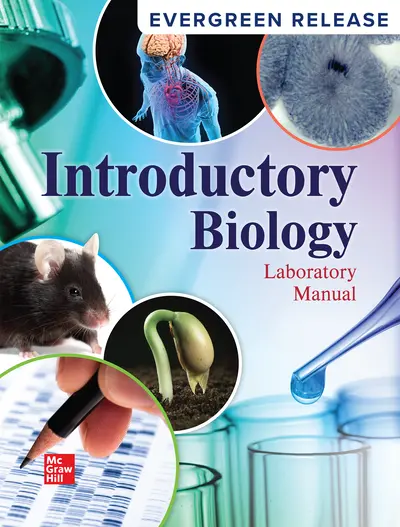My Account Details

ISBN10: 1265468435 | ISBN13: 9781265468439

Introductory Biology Laboratory Manual
Product not yet available for student view. Change to an older release to view student options.
-
Lowest Price!
-
-
McGraw Hill eBook
Loose-Leaf Purchase
- Unbound loose-leaf version of full text
- Discount loose-leaf available within Connect
Shipping Options
- Standard
- Next-day air
- 2nd-day air
Orders within the United States are shipped via FedEx or UPS Ground. For shipments to locations outside of the U.S., only standard shipping is available. All shipping options assume the product is available and that processing an order takes 24 to 48 hours prior to shipping.
Hardcopy
Complete text bound in hardcover or softcover
Shipping Options
- Standard
- Next-day air
- 2nd-day air
Orders within the United States are shipped via FedEx or UPS Ground. For shipments to locations outside of the U.S., only standard shipping is available. All shipping options assume the product is available and that processing an order takes 24 to 48 hours prior to shipping.
Note: Connect can only be used if assigned by your instructor.
Connect (360 Days Access)
- Digital access to a comprehensive online learning platform
- Includes homework, study tools, eBook, and adaptive assignments
- Download the free ReadAnywhere app to access the eBook offline
- Check with your instructor to see if a discounted loose-leaf version is available for purchase within Connect for an additional charge.
McGraw Hill eBook
Details:
- Normally the lowest price option for student
- Integrates in your LMS
- Accessible tools for students, including read-aloud functionality, jump links and dynamic note-taking and highlighting features
Loose-Leaf Purchase
Details:
- Unbound loose-leaf version of full text
Hardcopy
Connect (360 Days Access)
Details:
- Integrates in your LMS
- Prebuilt courses, presentation slides and instructor resources
- Test question banks, adaptive assignments, essay prompts, video content and more interactive exercises specific to your course subject
- eBook access (with included ReadAnywhere app)
- Print book add-on availability
- Remote proctoring
* The estimated amount of time this product will be on the market is based on a number of factors, including faculty input to instructional design and the prior revision cycle and updates to academic research-which typically results in a revision cycle ranging from every two to four years for this product. Pricing subject to change at any time.
The laboratory exercises in Introductory Biology Laboratory Manual cover the entire field of biology from an evolutionary perspective. There is a breadth of coverage that can be adapted to a variety of course orientations and designs, including a unit specifically for courses requiring human-focused labs. This lab manual can be customized to only include the specific exercises needed school-by-school.
All exercises have been tested for student interest, preparation and completion times, feasibility, and reliability of results. Directions to students are clear and follow common laboratory standards and practices.
This title is part of the Self Print Evergreen program, which means the McGraw Hill eBook will soon offer enhanced functionality, allowing students to print text content. With self-print enabled, students can easily access and print the most up-to-date material, including all Evergreen updates. By offering the McGraw Hill eBook either standalone or within our Connect or GO platforms, students gain access to this convenient print feature at no additional cost for print materials.
Need support? We're here to help - Get real-world support and resources every step of the way.
